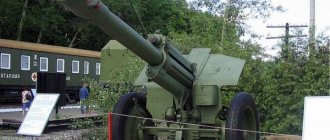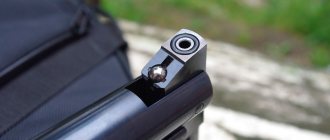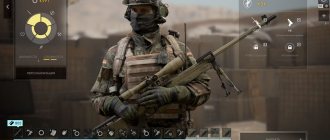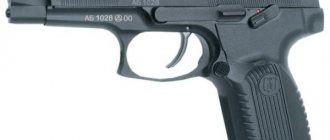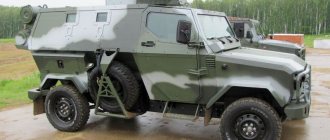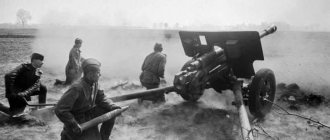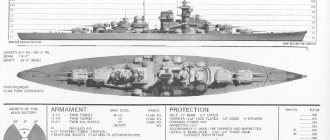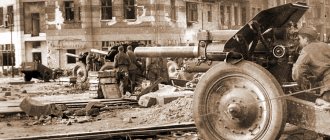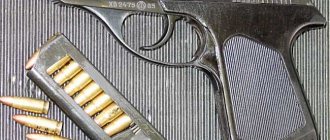Fragmentation projectile
- an artillery shell of the main purpose for destroying enemy personnel and unarmored military equipment, and solving a number of other problems. Compared to a universal high-explosive fragmentation projectile of the same caliber, it has a better fragmentation effect, but cannot be effectively used against fortifications. Along with an instantaneous impact fuse, fragmentation shells are equipped with a variety of remote-type fuses, depending on their purpose. For example, to defeat enemy personnel, firing fragmentation shells with a radio fuse is effective, providing an explosion at a low altitude above the location of enemy soldiers. To combat air targets, projectiles with fuses are used, ensuring their explosion after a certain flight time, reaching a given height or minimum distance from the target.
see also
- "VOG-25" "VOG-25r" - fragmentation ammunition for the GP-25 "Koster" under-barrel grenade launcher.
| Special purpose: | Propaganda | Smoke | Lighting | Sighting and target designation | Non-lethal |
| Auxiliary purposes | Carriage proof | Slab testing | Practical | Educational | Singles |
| BPs are also classified into sub-caliber/caliber/over-caliber, active/active-reactive/reactive | |
What is a cumulative weapon
The cumulative effect (action) is the process of increasing the impact on an object after an explosion and releasing the resulting power in a given direction.
See also the article Supersonic torpedo Shkval and its history
Cumulative projectile - capable of destroying armored vehicles.
To understand how a cumulative projectile works, you need to know that the energy released as a result of the explosion reaches speeds of up to 90 km/s. Such projectiles are used to destroy armored targets or reinforced concrete structures.
During use, cumulative projectiles form a directed jet, which has a high degree of penetration. When it collides with an object, a cumulative jet is released from the projectile using an explosive, which begins to move along the axis.
Contact with an object creates high pressure, which can penetrate armor. The power of such projectiles directly depends on the shape, materials used and explosives.
An excerpt characterizing the fragmentation projectile
“Je ne vous retiens plus, general, vous recevrez ma lettre,” Balashev was sure that Napoleon not only would not want to see him, but would try not to see him - the offended ambassador and, most importantly, a witness to his obscene fervor. But, to his surprise, Balashev, through Duroc, received an invitation to the emperor’s table that day. Bessieres, Caulaincourt and Berthier were at dinner. Napoleon met Balashev with a cheerful and affectionate look. Not only did he not show any expression of shyness or self-reproach for the morning outburst, but, on the contrary, he tried to encourage Balashev. It was clear that for a long time now the possibility of mistakes did not exist for Napoleon in his belief and that in his concept everything that he did was good, not because it coincided with the idea of what is good and bad, but because he did This. The Emperor was very cheerful after his horseback ride through Vilna, in which crowds of people enthusiastically greeted and saw him off. In all the windows of the streets along which he passed, his carpets, banners, and monograms were displayed, and the Polish ladies, welcoming him, waved their scarves at him.
Soviet cumulative anti-tank ammunition during the war
The cumulative effect of a directed explosion became known in the 19th century, shortly after the start of mass production of high explosives. The first scientific work devoted to this issue was published in 1915 in Great Britain.
This effect is achieved by giving explosive charges a special shape. Typically, for this purpose, charges are made with a recess in the part opposite to its detonator. When an explosion is initiated, a converging stream of detonation products is formed into a high-speed cumulative jet, and the cumulative effect increases when the recess is lined with a layer of metal (1-2 mm thick). The speed of the metal jet reaches 10 km/s. Compared to the expanding detonation products of conventional charges, in the converging flow of shaped charge products, the pressure and density of matter and energy are much higher, which ensures the directional effect of the explosion and the high penetrating force of the shaped charge jet.
When the conical shell collapses, the velocities of individual parts of the jet turn out to be somewhat different, as a result of which the jet stretches in flight. Therefore, a slight increase in the gap between the charge and the target increases the penetration depth due to the elongation of the jet. The thickness of the armor penetrated by cumulative shells does not depend on the firing range and is approximately equal to their caliber. At significant distances between the charge and the target, the jet breaks into pieces, and the penetration effect is reduced.
In the 30s of the 20th century, there was a massive saturation of troops with tanks and armored vehicles. In addition to traditional means of combating them, in the pre-war period, the development of cumulative projectiles was carried out in some countries. What was especially tempting was that the armor penetration of such ammunition did not depend on the speed of contact with the armor. This made it possible to successfully use them to destroy tanks in artillery systems that were not originally intended for this purpose, as well as to create highly effective anti-tank mines and grenades. Germany had advanced the most in the creation of cumulative anti-tank ammunition; by the time of the attack on the USSR, cumulative artillery shells of 75-105 mm caliber had been created and adopted there.
Unfortunately, in the Soviet Union before the war, due attention was not paid to this area. In our country, the improvement of anti-tank weapons proceeded by increasing the caliber of anti-tank guns and increasing the initial velocities of armor-piercing shells. To be fair, it should be said that in the USSR in the late 30s, an experimental batch of 76-mm cumulative shells was fired and tested. During the tests, it turned out that cumulative shells equipped with standard fuses from fragmentation shells, as a rule, do not penetrate armor and ricochet. Obviously, the problem was in the fuses, but the military, which already did not show much interest in such shells, finally abandoned them after unsuccessful firing.
At the same time, a significant number of recoilless (dynamo-reactive) Kurchevsky guns were manufactured in the USSR.
76-mm Kurchevsky recoilless rifle on a truck chassis
The advantage of such systems is their light weight and lower cost compared to “classic” guns. Recoilless rifles in combination with cumulative projectiles could quite successfully prove themselves as an anti-tank weapon.
With the outbreak of hostilities, reports began to arrive from the fronts that German artillery was using previously unknown so-called “armor-burning” shells that effectively hit tanks. When inspecting the damaged tanks, we noticed the characteristic appearance of holes with melted edges. At first, it was suggested that the unknown shells used “fast-burning thermite,” accelerated by powder gases. However, this assumption was soon refuted experimentally. It was found that the processes of combustion of thermite incendiary compositions and the interaction of the slag jet with the metal of the tank armor proceed too slowly and cannot be realized in a very short time for the shell to penetrate the armor. At this time, samples of “armor-burning” shells captured from the Germans were delivered from the front. It turned out that their design is based on the use of the cumulative effect of an explosion.
At the beginning of 1942, designers M.Ya. Vasiliev, Z.V. Vladimirov and N.S. Zhitkikh designed a 76-mm cumulative projectile with a conical cumulative recess lined with a steel shell. An artillery shell body with bottom equipment was used, the chamber of which was additionally bored into a cone in its head part. The projectile used a powerful explosive - an alloy of TNT and hexogen. The bottom hole and plug served to install an additional detonator and a beam detonator capsule. A big problem was the lack of a suitable fuse in production. After a series of experiments, the AM-6 aviation instantaneous fuse was chosen.
HEAT shells, which had armor penetration of about 70-75 mm, appeared in the ammunition load of regimental guns in 1943, and were mass-produced throughout the war.
Regimental 76-mm gun mod. 1927
The industry supplied the front with about 1.1 million 76-mm cumulative anti-tank shells. Unfortunately, their use in tank and divisional 76-mm guns was prohibited due to the unreliable operation of the fuse and the danger of an explosion in the barrel. Fuzes for cumulative artillery shells, meeting safety requirements when firing from long-barreled guns, were created only at the end of 1944.
In 1942, a group of designers including I.P. Dzyuba, N.P. Kazeikina, I.P. Kucherenko, V.Ya. Matyushkina and A.A. Greenberg developed cumulative anti-tank shells for 122-mm howitzers.
The 122-mm cumulative projectile for the howitzer of the 1938 model had a body made of steel cast iron, was equipped with an effective explosive composition based on hexogen and a powerful PETN detonator. The 122-mm cumulative projectile was equipped with the B-229 instantaneous fuse, which was developed in a very short time at TsKB-22, headed by A.Ya. Karpov.
122-mm howitzer M-30 mod. 1938
The projectile was put into service and put into mass production at the beginning of 1943, and managed to take part in the Battle of Kursk. Until the end of the war, more than 100 thousand 122-mm cumulative shells were produced. The projectile penetrated armor up to 150 mm thick along the normal line, ensuring the defeat of heavy German Tiger and Panther tanks. However, the effective firing range of howitzers at maneuvering tanks was suicidal - 400 meters.
The creation of cumulative shells opened up great opportunities for the use of artillery guns with relatively low initial velocities - 76-mm regimental guns of the 1927 and 1943 models. and 122-mm howitzers of the 1938 model, which were available in large quantities in the army. The presence of cumulative shells in the ammunition loads of these guns significantly increased the effectiveness of their anti-tank fire. This significantly strengthened the anti-tank defense of Soviet rifle divisions.
One of the main tasks of the Il-2 armored attack aircraft, which entered service at the beginning of 1941, was to fight armored vehicles. However, the cannon armament available to the attack aircraft could only effectively hit lightly armored vehicles. 82-132 mm rocket projectiles did not have the required firing accuracy. However, in 1942, cumulative RBSK-82 were developed to arm the Il-2.
RBSC-82
The head of the RBSK-82 missile consisted of a steel cylinder with a wall thickness of 8 mm. A cone made of sheet iron was rolled into the front part of the cylinder, creating a recess in the explosive substance poured into the cylinder of the projectile head. A tube ran through the center of the cylinder, which served “to transmit a beam of fire from the pin cap to the TAT-1 detonator cap.” The shells were tested in two versions of explosive equipment: TNT and alloy 70/30 (TNT with hexogen). The shells with TNT had an AM-A fuse, and the shells with the 70/30 alloy had an M-50 fuse. The fuses had a pin-type capsule of the APUV type. The RBSK-82 missile unit is standard, from M-8 missile shells filled with pyroxylin gunpowder.
A total of 40 RBSK-82s were used up during the tests, 18 of them by firing in the air, the rest by firing on the ground. Captured German Pz tanks were fired upon. III, StuG III and the Czech tank Pz.38(t) with reinforced armor. Firing in the air was carried out at the StuG III tank from a dive at an angle of 30° with salvoes of 2-4 shells in one pass. The firing distance was 200 m. The shells showed good stability along the flight path, but it was not possible to get a single drop into the tank.
The RBSK-82 cumulative action armor-piercing rocket-propelled projectile, filled with 70/30 alloy, penetrated 30 mm thick armor at any impact angle, and pierced 50 mm thick armor at a right angle, but did not penetrate it at a 30° impact angle. Apparently, the low armor penetration is a consequence of the delay in the firing of the fuse “from the ricochet and the cumulative jet is formed with a deformed cone.”
RBSK-82 shells in TNT ammunition penetrated 30 mm thick armor only at impact angles of at least 30°, and did not penetrate 50 mm armor under any impact conditions. The holes produced by penetrating armor had a diameter of up to 35 mm. In most cases, penetration of the armor was accompanied by spalling of the metal around the exit hole.
HEAT missiles were not accepted for service due to the lack of a clear advantage over standard rockets. A new, much more powerful weapon was already on the way - PTABs.
Priority in the development of small cumulative aviation bombs belongs to domestic scientists and designers. In mid-1942, the famous fuze developer I.A. Larionov, proposed the design of a light anti-tank bomb with cumulative action. The Air Force command showed interest in implementing the proposal. TsKB-22 quickly carried out design work and testing of the new bomb began at the end of 1942. The final version was PTAB-2.5-1.5, i.e. an anti-tank aviation bomb with a cumulative effect weighing 1.5 kg in the dimensions of a 2.5 kg aviation fragmentation bomb. The State Defense Committee urgently decided to adopt the PTAB-2.5-1.5 and organize its mass production.
The first PTAB-2.5-1.5 housings and riveted pinnate-cylindrical stabilizers were made from sheet steel 0.6 mm thick. To increase the fragmentation effect, a 1.5-mm steel jacket was additionally put on the cylindrical part of the bomb. The PTAB combat charge consisted of a mixed BB of the TGA type, equipped through the bottom point. To protect the AD-A fuse impeller from spontaneous collapse, a special fuse made of a square-shaped tin plate with a fork of two wire mustaches attached to it, passing between the blades, was put on the bomb stabilizer. After the PTAB was dropped from the aircraft, it was torn off the bomb by the oncoming air flow.
Upon impact with the tank's armor, a fuse was triggered, which, through a tetryl detonator block, caused the detonation of the explosive charge. When the charge detonated, due to the presence of a cumulative funnel and a metal cone in it, a cumulative jet was created, which, as field tests showed, pierced armor up to 60 mm thick at an impact angle of 30° with a subsequent destructive effect behind the armor: defeating the tank crew, initiating detonation of ammunition , as well as ignition of fuel or its vapors.
The bomb load of the Il-2 aircraft included up to 192 PTAB-2.5-1.5 bombs in 4 cassettes of small bombs (48 pieces each) or up to 220 pieces when they were rationally placed in bulk in 4 bomb bays.
The adoption of PTABs was kept secret for some time; their use without the permission of the high command was prohibited. This made it possible to use the effect of surprise and effectively use new weapons in the battle of Kursk.
The massive use of PTAB had a stunning effect of tactical surprise and had a strong moral impact on the enemy. German tank crews, however, like Soviet ones, by the third year of the war had already become accustomed to the relatively low effectiveness of air bombing strikes. At the initial stage of the battle, the Germans did not use dispersed marching and pre-battle formations at all, that is, on the routes of movement in columns, in places of concentration and in starting positions, for which they were severely punished - the PTAB flight line blocked 2-3 tanks, one distant from the other at 60-75 m, as a result of which the latter suffered significant losses, even in the absence of massive use of IL-2. One IL-2 from a height of 75-100 meters could cover an area of 15x75 meters, destroying all enemy equipment there. On average, during the war, irrecoverable tank losses from aviation did not exceed 5%; after the use of PTAB in certain sectors of the front, this figure exceeded 20%.
Having recovered from the shock, the German tank crews soon moved exclusively to dispersed marching and pre-battle formations. Naturally, this greatly complicated the management of tank units and subunits, increased the time for their deployment, concentration and redeployment, and complicated the interaction between them. In parking lots, German tank crews began to place their vehicles under trees, light mesh canopies, and install light metal meshes over the roof of the turret and hull. The effectiveness of IL-2 strikes using PTAB decreased by approximately 4-4.5 times, remaining, however, on average 2-3 times higher than when using high-explosive and high-explosive fragmentation bombs.
In 1944, a more powerful anti-tank bomb PTAB-10-2.5, with the dimensions of a 10-kg aircraft bomb, was adopted. It provided penetration of armor up to 160 mm thick. According to the principle of operation and purpose of the main components and elements, PTAB-10-2.5 was similar to PTAB-2.5-1.5 and differed from it only in shape and dimensions.
In the 1920s-1930s, the Red Army was armed with the muzzle-loading “Dyakonov grenade launcher,” created at the end of the First World War and subsequently modernized.
It was a 41-mm caliber mortar, which was put on the barrel of a rifle, fixed on the front sight with a cutout. On the eve of the Great Patriotic War, every rifle and cavalry squad had a grenade launcher. Then the question arose about giving the rifle grenade launcher “anti-tank” properties.
During the Second World War, in 1944, the VKG-40 cumulative grenade entered service with the Red Army. The grenade was fired with a special blank cartridge containing 2.75 g of VP or P-45 gunpowder. The reduced charge of the blank cartridge made it possible to fire a grenade at direct fire with the butt resting on the shoulder, at a range of up to 150 meters.
The cumulative rifle grenade is designed to combat lightly armored vehicles and enemy mobile vehicles not protected by armor, as well as firing points. The VKG-40 was used very limitedly, which is explained by the low accuracy of fire and poor armor penetration.
During the war, the USSR produced a significant number of hand-held anti-tank grenades. Initially these were high-explosive grenades; as the thickness of the armor increased, the weight of anti-tank grenades also increased. However, this still did not ensure penetration of the armor of medium tanks, so the RPG-41 grenade, with an explosive weight of 1400 g, could penetrate 25 mm armor.
Needless to say, what a danger this anti-tank weapon posed to those who used it.
In mid-1943, the Red Army adopted a fundamentally new cumulative action grenade, RPG-43, developed by N.P. Belyakov. This was the first cumulative hand grenade developed in the USSR.
Sectional view of the RPG-43 hand-held cumulative grenade
The RPG-43 had a body with a flat bottom and a conical lid, a wooden handle with a safety mechanism, a belt stabilizer and an impact-ignition mechanism with a fuse. Inside the case is placed a bursting charge with a cumulative conical recess lined with a thin layer of metal, and a cup with a safety spring and a sting fixed in its bottom.
At its front end of the handle there is a metal sleeve, inside of which there is a fuse holder and a pin holding it in the rearmost position. On the outside, a spring is put on the bushing and fabric tapes are laid, attached to the stabilizer cap. The safety mechanism consists of a folding bar and a pin. The hinged bar serves to hold the stabilizer cap on the grenade handle before it is thrown, preventing it from sliding or turning in place.
When throwing a grenade, the hinged bar separates and releases the stabilizer cap, which, under the action of a spring, slides off the handle and pulls the tapes behind it. The safety pin falls out under its own weight, releasing the fuse holder. Thanks to the presence of a stabilizer, the grenade flew head-first, which is necessary for optimal use of the energy of the grenade's cumulative charge. When a grenade hits an obstacle with the bottom of the body, the fuse, overcoming the resistance of the safety spring, is impaled on the sting by a detonator cap, which causes the explosive charge to detonate. The RPG-43's shaped charge penetrated armor up to 75 mm thick.
With the advent of German heavy tanks on the battlefield, an anti-tank hand grenade with greater armor penetration was required. A group of designers consisting of M.Z. Polevanova, L.B. Ioffe and N.S. Zhitkikh developed the RPG-6 cumulative grenade. In October 1943, the grenade was adopted by the Red Army. The RPG-6 grenade is in many ways similar to the German PWM-1.
German PWM-1 anti-tank hand grenade
The RPG-6 had a teardrop-shaped body with a charge and an additional detonator and a handle with an inertial fuse, a detonator capsule and a tape stabilizer.
The fuse firing pin was blocked by a pin. The stabilizer bands were placed in the handle and held in place by a safety bar. The safety pin was removed before throwing. After the throw, the safety bar flew off, the stabilizer was pulled out, the firing pin was pulled out - the fuse was cocked.
Thus, the RPG-6’s safety system was three-stage (the RPG-43’s was two-stage). In terms of technology, a significant feature of the RLG-6 was the absence of turned and threaded parts, the widespread use of stamping and knurling. Compared to the RPG-43, the RPG-6 was more technologically advanced in production and somewhat safer to use. RPG-43 and RPG-6 were thrown at 15-20 m, after the throw the fighter had to take cover.
During the war years, hand-held anti-tank grenade launchers were never created in the USSR, although work was carried out in this direction. The main anti-tank weapons of the infantry were still anti-tank rifles and hand anti-tank grenades. This was partly offset by a significant increase in the number of anti-tank artillery in the second half of the war. But during the offensive, anti-tank guns could not always accompany the infantry, and in the event of the sudden appearance of enemy tanks, this often led to large and unjustified losses.
Based on materials: https://operation-barbarossa.narod.ru/artelleria/76-mm-m1927.htm https://weapon.at.ua/load/261-1-0-540 https://ser-sarajkin .narod2.ru/ALL_OUT/AiKOut13/RBSK-82/RBSK-82002.htm
Story
In 1792, mining engineer Franz von Baader suggested that the energy of an explosion could be concentrated in a small area using a hollow charge. However, in his experiments, von Baader used black powder, which cannot explode and form the necessary detonation wave. The effect of using a hollow charge was first demonstrated only with the invention of high explosives. This was done in 1883 by the inventor von Foerster.
The cumulative effect was rediscovered, studied and described in detail in his works by the American Charles Edward Munro in 1888.
In the Soviet Union in 1925-1926, Professor M. Ya. Sukharevsky studied explosive charges with a notch.
In 1938, Franz Rudolf Thomanek in Germany and Henry Hans Mohaupt in the USA independently discovered the effect of increasing penetration power by using a metal lining of a cone.
For the first time in combat conditions, a shaped charge was used on May 10, 1940 during the assault on Fort Eben-Emal (Belgium). Then, to undermine the fortifications, German troops used two types of portable charges in the form of hollow hemispheres weighing 50 and 12.5 kg.
X-ray pulse photography of the process, carried out in 1939 - early 1940s in laboratories in Germany, the USA and Great Britain, made it possible to significantly clarify the principles of operation of a shaped charge (traditional photography is impossible due to flashes of flame and a large amount of smoke during detonation).
One of the unpleasant surprises of the summer of 1941 for tank crews of the Red Army was the use of cumulative ammunition by German troops. Damaged tanks showed holes with melted edges, which is why the shells were called “armor-burning” shells. On May 23, 1942, at the Sofrinsky training ground, tests were carried out of a cumulative projectile for a 76-mm regimental gun, developed on the basis of a captured German projectile. Based on the test results, on May 27, 1942, the new projectile was put into service.
In the 1950s, enormous progress was made in understanding the principles of cumulative jet formation. Methods for improving shaped charges with passive inserts (lenses) have been proposed, optimal shapes of shaped craters have been determined, methods have been developed to compensate for projectile rotation by corrugating the cone, and more powerful explosives have been used. Many of the phenomena discovered in those distant years are still being studied to this day.
Disputes about priorities
The term “cumulation” (Latin cumulatio - accumulation, summation) means the strengthening of any action due to addition (accumulation). During cumulation, due to a special charge configuration, part of the energy of the explosion products is concentrated in one direction. Several people who discovered it independently of each other claim priority in the discovery of the cumulative effect. In Russia - a military engineer, Lieutenant General Mikhail Boreskov, who used a charge with a recess for sapper work in 1864, and Captain Dmitry Andrievsky, who in 1865 developed a detonator charge for detonating dynamite from a cardboard sleeve filled with gunpowder with a recess filled with sawdust. In the USA - chemist Charles Munro, who in 1888, as legend has it, exploded a charge of pyroxylin with letters embossed on it next to a steel plate, and then drew attention to the same letters, mirrored “reflected” on the plate; in Europe - Max von Forster (1883).
At the beginning of the 20th century, cumulation was studied on both sides of the ocean - in Great Britain, Arthur Marshall, the author of a book dedicated to this effect, published in 1915, did this. In the 1920s, the famous explosives researcher Professor M.Ya. studied explosive charges with a notch (albeit without metal lining) in the USSR. Sukharevsky. However, the Germans were the first to put the cumulative effect into the service of the military machine, who began the targeted development of cumulative armor-piercing shells in the mid-1930s under the leadership of Franz Tomanek.
Around the same time, Henry Mohaupt was doing the same thing in the United States. It is he who is considered in the West to be the author of the idea of metal lining a recess in an explosive charge. As a result, by the 1940s, the Germans already had such shells in service.
Story
In 1792, mining engineer Franz von Baader suggested that the energy of an explosion could be concentrated in a small area using a hollow charge. However, in his experiments, von Baader used black powder, which cannot explode and form the necessary detonation wave. The effect of using a hollow charge was first demonstrated only with the invention of high explosives. This was done in 1883 by the inventor von Foerster.
The cumulative effect was rediscovered, studied and described in detail in his works by the American Charles Edward Munro in 1888.
In the Soviet Union in 1925-1926, Professor M. Ya. Sukharevsky studied explosive charges with a notch.
In 1938, Franz Rudolf Thomanek in Germany and Henry Hans Mohaupt in the USA independently discovered the effect of increasing penetration power by using a metal lining of a cone.
For the first time in combat conditions, a shaped charge was used on May 10, 1940 during the assault on Fort Eben-Emal (Belgium). Then, to undermine the fortifications, German troops used two types of portable charges in the form of hollow hemispheres weighing 50 and 12.5 kg.
X-ray pulse photography of the process, carried out in 1939 - early 1940s in laboratories in Germany, the USA and Great Britain, made it possible to significantly clarify the principles of operation of a shaped charge (traditional photography is impossible due to flashes of flame and a large amount of smoke during detonation).
One of the unpleasant surprises of the summer of 1941 for tank crews of the Red Army was the use of cumulative ammunition by German troops. Damaged tanks showed holes with melted edges, which is why the shells were called “armor-burning” shells. On May 23, 1942, at the Sofrinsky training ground, tests were carried out of a cumulative projectile for a 76-mm regimental gun, developed on the basis of a captured German projectile. Based on the test results, on May 27, 1942, the new projectile was put into service.
In the 1950s, enormous progress was made in understanding the principles of cumulative jet formation. Methods for improving shaped charges with passive inserts (lenses) have been proposed, optimal shapes of shaped craters have been determined, methods have been developed to compensate for projectile rotation by corrugating the cone, and more powerful explosives have been used. Many of the phenomena discovered in those distant years are still being studied to this day.

